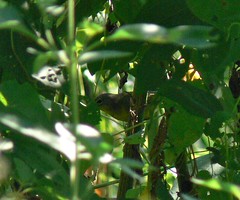Starting at about 7:30 I spent 3 and a half hours birding the neighborhood this morning. Fall migration is going strong! Out of the 45 species I found, 11 were south-bound migrants. On Broadmeade, just a little ways from my house I found a mixed species foraging flock that included a female Wilson's Warbler, a Yellow Warbler, and 1 or 2 other warblers that stayed too hidden for me to identify. Making my way down Stillforest I found at least 2 and maybe 3 Black-throated Green Warblers. They were first year birds, with extra bright yellow faces and without the black throats. I got this poor photo of one of them.
The rest of the way down Stillforest and then down Meadowheath mostly yielded resident birds except for a lone Blue-gray Gnatcatcher and a quick glimpse of a Summer Tanager.
At the T&C playing fields I turned left and crossed the footbridge onto Lake Creek Trail. It seemed slow at first, but there were birds hidden in the tall dense Johnson Grass and Giant Ragweed between the trail and the creek. I caught a few glimpses of them flitting in and out and heard a few unfamiliar chip notes, so I slowed down and staked out a spot. I made a guess at a chip note I was hearing and played a recording of a Mourning Warbler on my iPhone. Bingo! A first year bird responded and gave me a few good looks at it before it disappeared back into the brush. Mourning Warblers breed in the boreal forests of southern Canada and only pass through Texas during migration. They are often hard to see because they prefer low dense brush, and the first year birds are tricky to identify.
A minute later another bird I'd only glimpsed earlier finally emerged and flew right by my head across the trail. It was a Bell's Vireo. Like Mourning Warblers, this species also prefers low, thick vegetation. It breeds in Texas but I've only seen it in the neighborhood a handful of times, only during spring or fall migration. I also found a Painted Bunting. It was an all green bird, which means it's either a female or first-year male.
Near the parking lot I went into the tall grass by a group of willow trees and was able to find another first year Mourning Warbler. Although inconspicuous, this is actually one of the more common spring and fall migrating warblers you can find in the Austin area. It's one of the few neotropical migrant species that might actually be benefitting from humans since the habitat it prefers occurs in newly disturbed meadows and edges of forests. This time I was able to get one very poor photo. You can barely make out the broken eye-ring and yellowish throat that are diagnostic.
It was a fun morning! I was able to spend lots of time completely tuned-in to faint chip notes and tiny movements through the plants. When I do that there's not much else going on in my brain, and that's one of the things I love about birding.



No comments:
Post a Comment